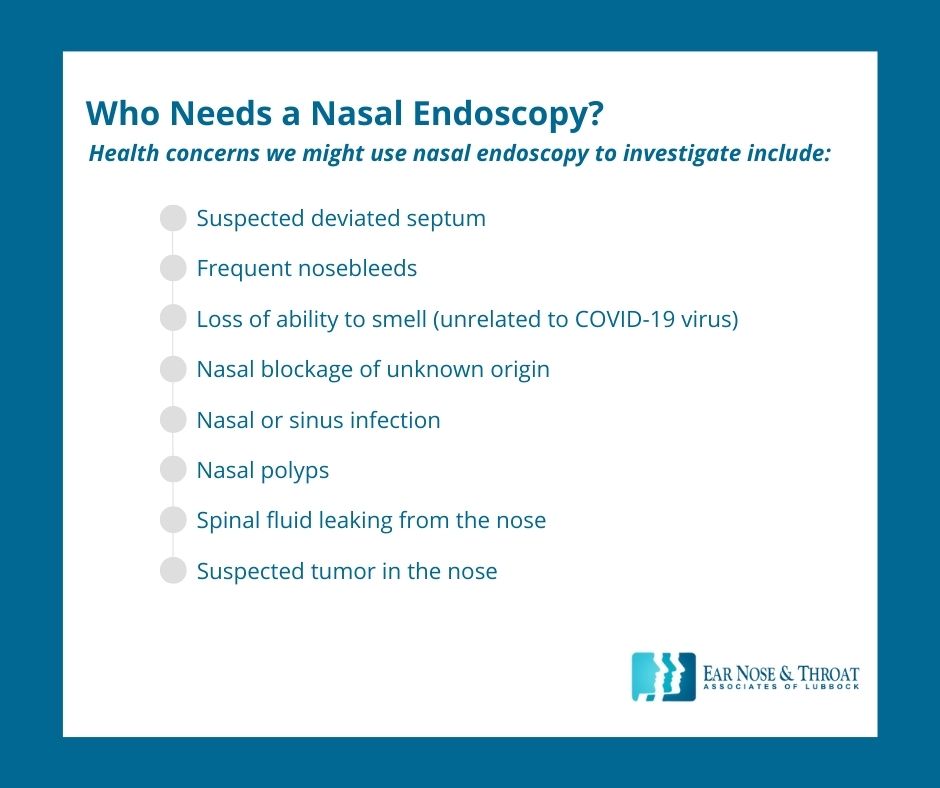What Is a Nasal Endoscopy and Do You Need One?

“Nasal endoscopy.”
Just the words sound intimidating. Your doctor wants to put a tube… where?
Fortunately, a nasal endoscopy is one of those scary-sounding medical terms that sounds much worse than it actually is.
Read on to find out why, despite how it sounds, a nasal endoscopy really isn’t bad at all — we promise!
What Is a Nasal Endoscopy?
A nasal endoscopy is a simple way for your ear, nose, and throat (ENT) doctor to look deeper inside your nasal passages. The physician first sprays a local anesthetic into your nose to numb your nasal passages and the back of your throat. They then insert an endoscope, a very thin tube with a tiny light and camera on its tip, into your nostril and use it to see all around inside the back of your nose and throat.
Depending on the purpose of the nasal endoscopy, your physician will use one of two kinds of endoscopes.

Flexible Endoscope Tubing
Sometimes your ENT just needs to take a quick look around inside your nose or throat. An exploratory nasal endoscopy like this usually involves a very flexible endoscope tube, which the physician guides with handheld controls. This tiny tube can turn and bend to allow the doctor a good view of anything they need to see. The camera on the end of the endoscope sends detailed video from within the nose to an eyepiece the physician wears.
Rigid Endoscope Tubing
Sometimes a physician needs to use an endoscope for more than just looking around. If they’re also performing a procedure, such as a sinus surgery, an ENT surgeon will use a rigid endoscope so the tube remains steady and in place. They can hold the rigid endoscope with one hand while operating the surgical instruments with the other hand. In this case, the endoscope’s camera usually sends video to a large monitor that the doctor, and sometimes even the patient, can see.
Who Needs a Nasal Endoscopy?
Since we can’t see all the way into the nose just by shining a light up a patient’s nostril, we often use an endoscope to look deeper. When a patient comes in with a complaint that we can’t entirely explain simply by looking up the nose with the naked eye, we can use a flexible endoscope to look for an explanation right there in the office.

Health concerns we might investigate using nasal endoscopy include:
- Suspected deviated septum
- Frequent nosebleeds
- Loss of ability to smell (unrelated to COVID-19 virus)
- Nasal blockage of unknown origin
- Nasal or sinus infection
- Nasal polyps
- Spinal fluid leaking from the nose
- Suspected tumor in the nose
Patients may also need a nasal endoscopy as part of a separate procedure, like endoscopic sinus surgery.
Risks and Side Effects of Nasal Endoscopy
A nasal endoscopy is incredibly low risk. Many times, the complications from medical procedures arise from the general anesthesia. Nasal endoscopy carries none of those risks since it only involves a topical numbing spray that wears off shortly afterward.
In essence, a nasal endoscopy is just looking around. You can think of it similarly to how you’d view a doctor looking into your ear or your mouth. You don’t have to worry about side effects or complications from a tongue depressor, and you don’t have to worry about them with a nasal endoscopy either.
If you’re nervous about feeling pain from a nasal endoscopy, you don’t have to worry. While you may feel a small amount of pressure, you shouldn’t feel any pain at all. As far as after-effects, the worst you might experience is a little nosebleed, and even that is rare.
At ENT Associates of Lubbock, we’ve been performing nasal endoscopies five to ten times per day every day for many, many years. After tens of thousands of nasal endoscopies, we’ve never had a complication.
Before, During, and After Your Nasal Endoscopy
Because a simple nasal endoscopy isn’t surgery, there’s nothing you need to do to prepare. You don’t need to fast or take any special antibiotics. We’ll give you a quick spritz of lidocaine to make sure your nose is numb before inserting the endoscope. The whole process only takes a few minutes, and then you’re on your way!
Dr. Cuthbertson is a physician at Ear Nose & Throat Associates of Lubbock. He joined the team at ENT Lubbock from Houston, where he was chief resident of the prestigious Bobby R. Alford Department of Otolaryngology at Baylor College of Medicine. He is board certified in Otolaryngology and Head & Neck Surgery and has quickly built a reputation, not only as an extremely skilled surgeon, but as an approachable and compassionate clinician adept in the newest standards and technologies. Learn more about Dr. Cuthbertson.
Categories:








